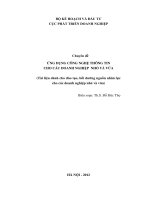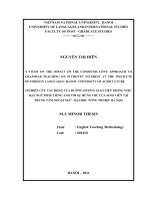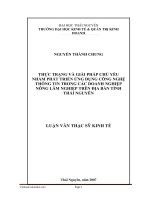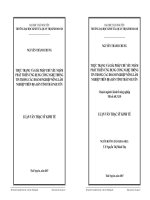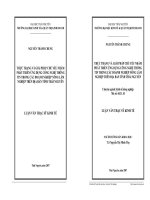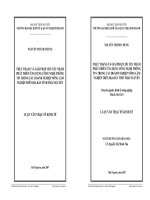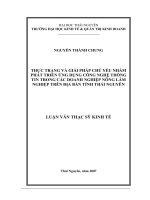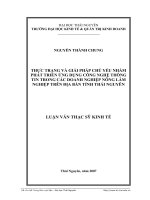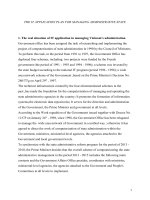Nghiên cứu tác động của công nghệ thông tin đến các yếu tố cấu thành năng lực cạnh tranh của các doanh nghiệp tại thành phố cần thơ tt tiếng anh
Bạn đang xem bản rút gọn của tài liệu. Xem và tải ngay bản đầy đủ của tài liệu tại đây (1.03 MB, 23 trang )
MINISTRY OF EDUCATION AND TRAINING
CAN THO UNIVERSITY
NGUYEN TRUNG NHAN
RESEARCH ON THE INFLUENCES OF INFORMATION TECHNOLOGY TO
ELEMENTS IN COMPETITIVENESS CAPACITY IN MANY ENTERPRISES
LOCATED IN CAN THO CITY
BUSINESS MANAGEMENT
MAJOR CODE: 62.34.01.02
SUMMARY OF PHD THESIS IN ECONOMICS
CAN THO - 2019
1. Nguyen Trung Nhan, Luu Thanh Duc Hai (2018). Impact of IT on the
competitiveness of businesses in Can Tho city. Journal of Finance, Part 1 - March 2018
(676), page: 113-116
2. Nguyen Trung Nhan, Luu Thanh Duc Hai (2018). Proposing a model to measure
the impact of IT on the components of competitiveness of businesses. Science Journal
of Can Tho University, Volume 54, Issue 6 (2018) pp: 215-223.
3. Nguyen Trung Nhan, Luu Thanh Duc Hai (2019). The impact of IT on the
factors that lead to the competitiveness of businesses in Can Tho city. Science Journal
of Can Tho University, Volume 55, Number of Economics Topic (2019) page: 95-107.
ii
CHAPTER 1
INTRODUCTION TO THE RESEARCH PROJECT
1.1 THE ISSUES AND NECESSITIES
1.1.1 THE ISSUES
In order to improve the competing capability, businesses must offer products and
services with higher quality and convenience to consumers. To achieve that goal,
businesses must apply scientific and technological achievements to market research,
management of input resources, production and business process management,
human resource management, financial management and output management. All
these jobs which are supported by information technology (IT) will help businesses
to deploy more smoothly, quickly and effectively. It will contribute to improve the
competing capability, especially in the current Industrial Revolution 4.0 era.
Today, IT has made great progress, it presents and plays an important and
indispensable role in all activities of social life, especially in activities of businesses.
1.1.2 THE NEED FOR RESEARCH
Today, in our country, the investment and application of IT in production and
business activities are getting more and more attention from businesses. This
becomes more important than before as the development and competition among
businesses is growing, foreign companies appear more and more, IT achievements
have been applied to the management system of state agencies and production and
business activities of businesses in the market ... If businesses do not invest in IT
application, they will be eliminated and will not have access to new benefits that IT
brings.
Can Tho city has increased investment, applied IT in state agencies and initially
formed the foundation for e-government; businesses in the city have invested and
applied IT in increasing production and business activities, creating conditions to
improve the competing capability for businesses in the process of regional and global
economic integration.
1.1.3 NOVELTY OF THE THESIS
There have not had any research projects or scientific projects yet on a national
level in Vietnam about the impact level of common IT factors to the elements that
constitute the competitive capability of businesses in a systematic manner.
This topic is considered to be an exploratory research, a desire to supplement
and complete the theoretical basis, deploy an empirical model on IT factors affecting
1
the components of the competing capability of businesses at Can Tho city.
Previous studies have considered IT factors as a component of the competing
capability (belonging to Science and Technology). This study isolates the IT factor to
evaluate the impact on the remaining factors in the competitive competence of
businesses at the Can Tho city.
Stemming from the aforementioned issues, the author has chosen the topic:
"Research on the influences of Information Technology to elements in
competitiveness capacity in many enterprises located in Can Tho City" as the
content of the thesis.
1.2 RESEARCH OBJECTIVES
1.2.1 GENERAL OBJECTIVES
The objective of the thesis is to study the impact of Information Technology on
the constituent elements of competing capability of businesses in Can Tho city,
thereby proposing management implications to improve the competing capability of
businesses in Can Tho city.
1.2.2 SPECIFIC OBJECTIVES
Assessing the current situation of IT application of businesses in Can Tho city,
the constituent elements of the competing capability of businesses in the area of Can
Tho city.
Analyzing and auditing the impact of IT on the constituent elements of the
competing capability of businesses in Can Tho city.
Proposing the management implications to improve IT impact on the competing
capability of businesses in Can Tho city.
1.3 RESEARCH QUESTIONS
Question 1: How is the reality of applying IT and the constituent elements of the
competing capability of businesses in the localities of Can Tho city?
Question 2: What is the impact of IT on the constituent elements of competing
capability of businesses in Can Tho city today?
Question 3: To improve the competing capability of businesses in Can Tho city,
how should the impact of IT be used?
1.4 OBJECTS AND SCOPE OF THE RESEARCH
1.4.1 OBJECTS OF THE RESEARCH
2
The research object of the thesis is enterprises in Can Tho City via evaluating the
impact of IT on the constituent elements of competing capability of businesses
currently.
The object of the thesis survey is the experts, Board of Directors, Chief
Accountant and managers (departmental level) of businesses in the locality of Can
Tho city in applying IT to business activities of businesses
1.4.2 SCOPE OF THE RESEARCH
1.4.2.1 Space range
The study focused on businesses in the area of Can Tho city, focusing on 05
districts: Ninh Kieu, Binh Thuy, Cai Rang, O Mon and Thot Not. These are places
with the largest number of businesses.
1.4.2.2 Time range
Research period: secondary data used in the thesis was collected in the period of
2014 – 2017, and additionally in 2018, 2019. Primary survey data was collected
mainly in 2017 and supplemented in 2018.
1.4.2.3 Content range
The research thesis is conducted for businesses of all economic sectors operating
in key fields in Can Tho city; at the same time studying the impact of IT on the
internal and external factors that make up the competing capability of these
businesses.
1.5 THE SCIENTIFIC AND PRACTICE MEANING OF THE THESIS
1.5.1 SCIENTIFIC MEANING
The thesis is done with the following scientific meanings:
- The thesis conducts document review, selectively inherits and systematizes
previous studies related to IT architecture framework in businesses, Competition
issues, competitive advantage and competing capability in businesses; thereby
proposing models, research processes, hypotheses and scales related to assessing the
impact of IT on the components of competitive competence of businesses in Can Tho
city
- Using a combination of qualitative and quantitative research methods.
Regarding these methods, the thesis mainly uses quantitative method to determine
the impact of IT on each element that constitutes the competing capability of
businesses.
3
- The research results will test the analysis, hypotheses, empirical conclusions
and propose management implications in accordance with current IT investment and
application practices in businesses in Can Tho city currently; thereby suggesting
policy implications for state agencies to encourage, facilitate investment promotion
and IT application for businesses in the coming time.
1.5.2 Practical meaning
- This research stems from the general policy of the Party and the State and the
practical needs of life is to promote the application of IT in organizations and
businesses; is a research and discovery to add to the theoretical basis and empirical
model on IT impacting the constituent elements of competing capability of
businesses in Can Tho City.
1.6 STRUCTURE OF THE THESIS
In addition to the summary and conclusion, the thesis is divided into 5 chapters
presented with the following structure:
- Chapter 1: Introduction to research topics
- Chapter 2: Research overview
- Chapter 3: Theoretical foundations and research methods;
- Chapter 4: Research results and discussion;
- Chapter 5: Conclusion and management implications.
4
CHAPTER 2
RESEARCH OVERVIEW
2.1 RESEARCH WORKS ON IT ARCHITECTURAL FRAMEWORK
Architecture framework or IT model is determined by EA Zachman. It is
supplemented by new version developed based on EA framework and FEAF –II
(USA), TOGAF from Open Group and VGAF v 2.0 in Vietnam.
Regarding reference, the standard framework determines IT architecture
framework (or model) in modern businesses following 06 main factors:
(1) Technical infrastructure (hardware, software, network, cloude, ...),
(2) Database (Data),
(3) Information system (information),
(4) Applications (Portal, website, social networks, blogs),
(5) Users (operators, operators), and
(6) Information security
In particular, the technical infrastructure system is considered a foundation
factor of the Architectural Framework and Information Security is considered a new
and important factor that has an impact on the remaining factors.
2.2 RESEARCH PROJECTS ON COMPETING CAPABILITY
There are many studies (both domestic and foreign) about the constituent
elements of competing capability of businesses, each research project determines the
constituent elements of competing capability of businesses are also different. These
factors are described in the form of a specific "framework" or "model" of competing
capability. Competing capability can be considered as a dependent or independent
variable, depending on the perspective from which a person approaches the problem
(A. Ambastha and K. Momaya, 2003). The typical international researches include
Marc Vilanova và ctg (2009); Olga Nykolyuk (2014); Dragan oćkalo và partner
(2019). The typical domestic researches include Nguyen Đinh Tho and partner
(2009); Ninh Đuc Hung and partner (2011), Huynh Thanh Nha and partner (2013);
Pham Viet Hung and partner (2017).
The studies have built an important theoretical foundation and identified the
basic internal factors that determines the competitive competence of enterprises: (1)
Market, (2) Capital mobilization (3) Marketing, (4) Governance, management, (5)
Technology, (6) Resources (human resources), (7) Public relations, (8) Others
(reputation, brand, strategy).
5
2.3 THE STUDY ON THE IMPACT OF INFORMATION TECHNOLOGY
ON
THE
CONSTITUENT
ELEMENTS
OF
THE
COMPETING
CAPABILITY OF BUSINESSES
Basic determination of factors belonging to c capability affected by IT in
businesses are as follows:
Table: Summary of competing capability elements influenced by IT
TT
1
2
3
ELEMENTS
REPRESENTATIVE AUTHOR
Technical
Moon- Koon Kim, 2007; Nguyen Minh
infrastructure
Ngoc, 2011; Tanja Mihalič et al (2013)
Human Resources
GHI CHÚ
Moon- Koon Kim, 2007; Nguyen Minh
Ngoc, 2009; Ravarini, 2010;
Management
Nguyen Minh Ngoc, 2011; Tanja Mihalič
Most of the
capacity
et al (2013)
researches
Ravarini, 2010; Tanja Mihalič et al
Most of the
(2013)
researches
Ravarini 2010; Tanja Mihalič et al
Most of the
(2013);
researches
4
Relationship
5
Financial resource
6
Business market
7
Business strategy
Raykun R.Tan (1995), Moon-Koon Kim
et al, 2007
Moon-Koo Kim et al 2007
Source: Authors' summary, 2018
6
CHAPTER 3
THEORETICAL BASIS AND RESEARCH METHODS
3.1 THEORETICAL BASIS
3.1.1 Theoretical basis of IT architecture framework in businesses
- EA Zachman architectural framework (1992)
- FEAF-II architectural framework (United States, 2013);
- TOGAF architectural framework (Open Group, 2016);
- VGAF v2.0 architecture framework (Vietnam, 2019);
- Standard framework.
3.1.2 Theoretical basis of the components of competing capability of
businesses
- “5 competitive pressures” model of M. Porter
- PESTEL analysis model
- Resource Based View Theory (RBV)
3.1.3 The theory about IT affecting the competing capability of businesses
- Dynamic ability theory (Teece & et al. 1997; Eisenhardt & Martin 2000).
From the theory of resources and the empirical studies mentioned above, we can
conclude that IT is one of the important resources affecting the competing capability
of businesses, IT resources are classified in the following order: (1) tangible
resources include IT infrastructure components, physical infrastructure, (2) human IT
resources including managerial and technical IT skills, and (3) intangible support
resources. IT as knowledge assets, customer orientation and synergy (Konstantinos
C. Kostopoulos et al, 2003).
On the basis of the literature review in Chapter 2 and theoretical basis mentioned
above, the author proposes a method to study the impact of IT on the constituent
elements of competing capability of businesses as follows:
3.2 RESEARCH METHODS
3.2.1 Qualitative research
After the Council approved the Research Outline, the author conducted a
document review, identified the theoretical basis, collected primary data related to
the analysis and evaluation of business activities in Can Tho City, assessed the
development of some IT fields in Vietnam and IT application of enterprises in Can
Tho City.
7
To identify research subjects based on the structure of enterprises in the
province. Each individual learns about research’ contents (experts), select
preliminary investigation enterprises, and support clues in research process.
Qualitative research is carried out in 03 parts:
- To evaluation the IT development through indicators related to IT fields and
ranking announcements of IT application;
- Evaluation the enterprises in Can Tho City: mainly evaluating the general
situation, apply IT application in enterprises operating in Can Tho City; analysis of
capital, labor, revenue, profit, employee's income, ...
- Evaluation of the competitive competence of enterprises in Can Tho City
through some typical studies and published articles in scientific journals,
journalism, ...
When selecting expert interview members, the author selected the following
subjects and numbers:
- Quantity: 24 experts
- Composition: Directors of Departments, branches and centers of Can Tho City;
Head of administrator and leader of faculty at Universities which have IT education;
Business Director; Chief Accountant, Sales Manager and some other independent
experts.
3.2.2 Quantitative research
- Phase 1: Preliminary research
+ This phase consists of two main parts (1) on the basis of theoretical research
and related financial profiles, the author will conduct the establishment of a Test
Scale (draft) to consult with experts and discuss with the group and (2) proceed to
adjust the appropriate scale, conduct preliminary quantitative research (about 72
units). After obtaining the data collected through preliminary research, the author
will conduct data cleansing (70 units were selected), enter the data into the software
and conduct the Cronbach’s test ”Alpha and analyze discovery factor EFA.
+ After obtaining the test results, the author consulted with the instructor,
analysts and business leaders who have strong IT applications (List of experts) to
consider removing abnormal numbers in the analytical results. Conducting
assessment and adjustment of the set of scales suitable to the study.
- Phase 2: Official research
8
+ After adjusting the scale, the author has repeatedly consulted the instructor and
experienced experts in two related fields: IT and Business Administration in order to
build an official scale of competitive competence in enterprises and complete the
research model. After agreeing on the scale, the author determines the content to be
collected and proceeds to set up an official businesses investigation questionnaire
according to the subjects and scope of the study.
+ After the survey data, the author has cleaned the data, resulting in more than
350 satisfactory business questionnaires, but the author decided to choose the most
complete 350 votes for official analysis using qualitative analysis tools Cronbach's
Alpha, EFA, CFA and SEM according to the selected research process. The author
has used SPSS and AMOS software version 20.0 to analyze the data and check the
hypotheses.
9
Preliminary research
Theoretical basis
Consulting relevant
documents
Test scale
(draft)
Thảo luận nhóm - Tham khảo
ý kiến chuyên gia
Preliminary
Scale
Quantitative
Preliminary
Research (n = 70)
Preliminary
assessment of the scale
Check Cronbach’s alpha
coefficient
Analyze EFA factor
Set of
scales
Official Research
( n = 350)
Check the EFA weights, factors
and extracted variances
Analyze CFA
Official Research
Official
Scale
Check the model's suitability, CFA weight,
unidirectional aggregate reliability, convergence
value and differentiation
Checking model suitability, theoretical and
hypothetical contact value, estimating models
Source: Proposal of the author, 2017
Figure 3.1 Proposed research procedure
10
Analyze CFA
SEM model
3.3 PROPOSED RESEARCH MODEL
In this study, the author has chosen the solution is to evaluate the impact of
general IT factors instead of assessing the impact of each factor in the IT architecture
framework of businesses on the constituent elements of competing capability of
businesses. Proposed research model:
Competitiveness
Factors constitute
competitiveness
in enterprises
IT
Social
Relation
-ship
Market
Finance
Promotion
Organization
Resources
Source: Proposal of the author, 2018
Figure 3.2: Official research model
Scale and Hypothesis:
Hypothesis H1: IT have an impact on the Market-oriented capacity factors in
businesses activities
Hypothesis H2: IT have an impact on the factors of ability to mobilize capital in
businesses activities
Hypothesis H3: IT have an impact on the elements of marketing capacity in
businesses activities
Hypothesis H4: IT have an impact on the elements of organizational
management capacity in businesses activities
Hypothesis H5: IT have an impact on the factors of resource capacity in
businesses activities
11
Hypothesis H6: IT have an impact on the elements of social relations in
businesses activities
Hypothesis H7: IT have an impact on the constituent elements of competing
capability of businesses
12
CHAPTER 4
RESULTS AND DISCUSSION
4.1 THE RESULTS OF ANALYSING DESCRIPTION STATISTICS
The results of the survey on factors affecting the competitive competence of
medium and small companies in Can Tho city with the average value of the sample
population (350 businesses) are described in the following table:
Through analysis data, it shows that the impact of IT on the constituent elements
of competing capability of businesses in Can Tho city is only average and still quite
low, this is reflected in the average value of the scale. (with Mean value) ranging
from 3.19 to 3.78.
In fact, the business efficiency of businesses in Can Tho city due to the
difference in business results between manual methods (not using IT) and with IT
application is not too large, so the application of IT of medium and small companies,
especially in production and business, has not been really paid attention. The
difficulties that many businesses encounter when applying IT are funding, lack of
information about products / services, and limited IT skills of employees.
Common IT applications in businesses are mainly accounting software, customer
management software, sales management, etc., still simple and local; businesses in
Can Tho have not paid much attention to investing, applying IT, and programs
lacking systematic and highly integrated applications, thus restricting businesses in
improving the management efficiency and their competing capability. Increasing
requirements for IT application, cooperation and information sharing in skills and
more integration of resources are vital issues of businesses.
4.2. EVALUATION OF THE IMPACTS OF IT TO THE CONSTITUENT
ELEMENTS OF COMPETING CAPABILITY OF BUSINESSES
4.2.1 Testing the scale using Cronbach's Alpha coefficient
The results of the reliability analysis show that the Cronbach’s Alpha
coefficients of the scales are all above 0.60. The lowest is the Management Capacity
scale (α = 0.770), the highest is the Technology Application Capacity scale (α =
0.899). Looking at the correlation coefficient of the total variable, it is found that the
observed variables have a quite strong correlation coefficient between the observed
variables (the lowest is the MA05 observed variable with a total correlation of 0.486
and the highest is XH03 with a total correlation of 0.774).
13
4.2.2 Testing the relationship of variables in the model by analyzing EFA
discovery factor
EFA analysis for 7 groups of factors affecting the competing capability includes
30 observed variables. The results of the first factor analysis show that the variables
are extracted into 7 groups, with the following results:
- The total variance extracted is 53.41%> 50%, showing that the variables in the
model can explain 53.41%, the scale is accepted.
- KMO coefficient = 0.928 within 0.5 ≤ KMO ≤ 1, this is the index used to
consider the suitability of factor analysis. A large KMO value means that factor
analysis is appropriate.
- Test Bartlett with Sig. = 0,000, is statistically significant (Sig. <0.05): This is a
statistical quantity used to consider the hypothesis that the variables have no
correlation in the whole. Factor loading of each group is greater than 0.5. Therefore,
the results of this factor analysis are accepted.
EFA analysis for the competing capability variables includes 03 observed
variables. The results of the first factor analysis show that the variables are extracted
into 1 group as follows:
- The total variance extracted is 65.62%> 50%, the scale is accepted.
- KMO coefficient = 0.719 is within 0.5 ≤ KMO ≤ 1, factor analysis is
appropriate
- Test Bartlett with Sig. = 0.00, indicating a high level of significance.
- All Factor loading value of each group > 0.5.
Table 4.1: A result of EFA analysis related to dependent variable
Symbol
Factor loading
1
NLCT2
0,888
NLCT1
0,799
NLCT3
0,752
Source: Results of official data processing in 2018
Therefore, the results of this factor analysis are accepted.
4.2.3 Results of positive factor analysis
With the scale of competing competence, the CFA method was performed with
33 observed variables extracted from EFA discovery factor analysis results. The
analyzed results are as follows:
14
Source: Official data processing results, 2018
Figure 4.1 Results of CFA affirmation analysis
To assess the suitability of the model, this study uses the following criteria: Chi
squared (required: P> 5%); chi-squared adjusted according to degrees of freedom
(CMIN / DF <3); IFI index is close to 1; IFI index> 0.9; TLI index> 0.9 and RMSEA
index <0.05.
15
4.2.4 SEM test on the impact of IT on the constituent elements of the
competing capability of businesses
SEM test results are as follows:
Source: Official data processing results, 2018
Figure 4.2 SEM test results
16
Table 4.2: Results of discriminatory value analysis (SEM) related to IT factors
Relationships
Competing
Capability
Competing
Capability
Competing
Capability
Competing
Capability
Competing
Capability
Competing
Capability
Competing
Capability
Estimate
S.E.
C.R.
P
<---
CN
0,380
0,099
3,845
***
<---
TT
-0,161
0,077
-2,098
0,036
<---
QL
-0,289
0,106
-2,718
0,007
<---
MA
0,252
0,111
2,282
0,022
<---
NL
0,050
0,071
0,710
0,478
<---
XH
0,169
0,074
2,281
0,023
<---
NV
0,086
0,039
2,208
0,027
Source: Official data processing results, 2018
After reviewing the model's suitability: Chi-square / df = 1,773; IFI = 0.933; TLI
= 0.924; CFI = 0.933; RMSEA = 0.047, the study obtained a final estimation model.
The coefficient P = 0.000 of the whole model but for each Resource mobilization
capacity factor (NL) is greater than 0.05 but less than 1 so with a relatively large
number of observations testing, this is acceptable; there are two factors: Market
Capability (MC) and Organizational and Management capabilities (OM) are both
negative values (-), and are inversely related to the competing capability factor; The
technological capacity has the strongest impact on the competing capability of
businesses.
4.2.5 Testing and estimating models with Bootstrap
Regarding the results, it shows that the bias and the standard deviation of the
bias (SE-Bias) with the optimal estimate used in the verification study are present but
not too large (most absolute CR values < 2), proving that the estimated results in the
study are reliable. In other words, the initial estimate of 1,000 observations is
averaged and this value tends to be close to the estimate of the population, the bias of
the estimate and its standard deviation have a small and stable value. Therefore, we
17
can conclude that the estimates in the SEM model the impact of IT on the constituent
elements of competing capability of businesses are reliable.
4.2.6 Conclusion of research hypotheses
Through the above analysis, the hypotheses are accepted as follows:
H1. There is an inverse relationship between the impact of information
technology on the ability of market-oriented capacity that constitute the competing
capability of businesses
H2. There is a positive relationship between the impact of information
technology on the factor of capital mobilization capacity that constitutes the
competing capability of businesses.
H3. There is a positive relationship between the impact of information
technology on the marketing capability element that constitutes the competing
capability of businesses.
H4. There is an inverse relationship between the impact of information
technology on the organizational and management factors that constitute the
competing capability of businesses.
H5. There is a positive relationship between the impact of information
technology on the factor Capacity to mobilize resources that constitutes the
competing capability of businesses.
H6. There is a positive relationship between the impact of IT on the social
relations element that constitutes the competing capability of businesses.
In addition, there is a positive relationship between the impact of IT on the
competing capability of businesses
18
CHAPTER 5
CONCLUSION AND MANAGEMENT IMPLICATIONS
5.1 CONCLUSION
All the components have impact on competing capability of businesses, with
both Social Relationship and Capacity to mobilize the resources are 2 factors that
have the strongest impact on competing capability. This is explained today,
businesses in Can Tho city with IT applications mainly invest in network
infrastructure, resource management software, design sales websites, transaction
forms. with customers, partners, other businesses and participate in public services
with government agencies.
There are 02 elements, Market Orientation and Management Organization
capacity which are inversely related to competing capability of businesses. Due to
the latency of the research data (collected in a timely manner), in addition, businesses
in Can Tho are mostly small and medium-sized so priority should be given to
investment in customer-oriented areas.
5.2 MANAGEMENT IMPLICATIONS
- Enhancing market-oriented capacity: Businesses need to exploit the
application of Internet to have a high efficiency in market research through building
an updated and complete customer data system. Market research online saves costs
for businesses and time for customers.
- Raising capital mobilization capacity: Financial activities using modern
methods should be encouraged and facilitated (such as buying, selling, providing
services and payment online) to help improve operational efficiency, save time and
cost based on digital platform, digital finance, ... are new directions to improve the
financial market of businesses following the current trend. In addition, businesses
can apply IT to manage supply chains, secure payment for suppliers, take advantage
of buyers' reputation to access bank capital …
- Enhancing marketing capacity: Using Internet to implement digital
marketing, electronic effects, social media to promote the image of businesses and
products. Internet minimizes cost and brings much greater efficiency than the
traditional method of sending mail advertising: no stamps, no packaging, no paper
and other costs.
- Improve management organization capacity: Implement businesses
management tools based on comprehensive and integrated IT application platform;
19
implement standardization and digitalization of resources and focus on developing
knowledge and skills of human resources, such as: foreign language competence;
basic knowledge about culture, society, history in international business;
international communication and dealing with cultural differences in business;
international practices and laws in the field / business.
- Enhancing technology application capacity: Investing in modern equipment
infrastructure for businesses to implement IT application and automation; focusing
on investment in network infrastructure and Internet connection is a technical
condition for businesses to apply IT on all businesses and participate in the ecommerce market; usage of application software in operation and management;
improve the capacity of human resources using IT; at the same time enhance the
security of IT systems for businesses.
- Enhancing the capacity of mobilizing resources: Increasing access to new
management methods (such as ERP, CRM, SCM systems) in order to improve the
management efficiency in the entire business. In particular, paying attention to the
business resource management system (ERP) will fundamentally change the entire
information system in businesses and affect the two resources of businesses,
technology and people; at the same time requires human resources of businesses to
gradually improve their qualifications to be able to adapt to changes in the new
management system.
- Building the capacity of Social Relations: From the results of the SEM
model, the application of IT in establishing, developing and preserving relationships
has important meanings, positively affecting the competing capability in businesses.
Businesses can tighten relationships with customers (partners), collect all possible
information about customers (partners). Businesses can buy customer relationship
management applications to ensure that customers are automatically answered
immediately after sending a request to the business or can build a good relationship
with customers and partners in business through electronic marketing, from there, it
is possible to classify each customer group to have an appropriate customer care
policy.
In summary, this is an empirical study related to analyzing and assessing the
impact of IT on the constituent elements of competing capability of businesses in the
Can Tho city area, through this study, the author reports on his learning results and
research in the PhD course at Can Tho University. These are initial research results,
20
confirming that IT has an impact on the constituent elements of competing capability
of businesses in Can Tho city and the thesis also has limitation and mistakes. In the
future, if possible, the author will study more deeply on this topic because this is a
field with great potential and high practical value in the current
Revolution 4.0 era./.
21
Industrial
